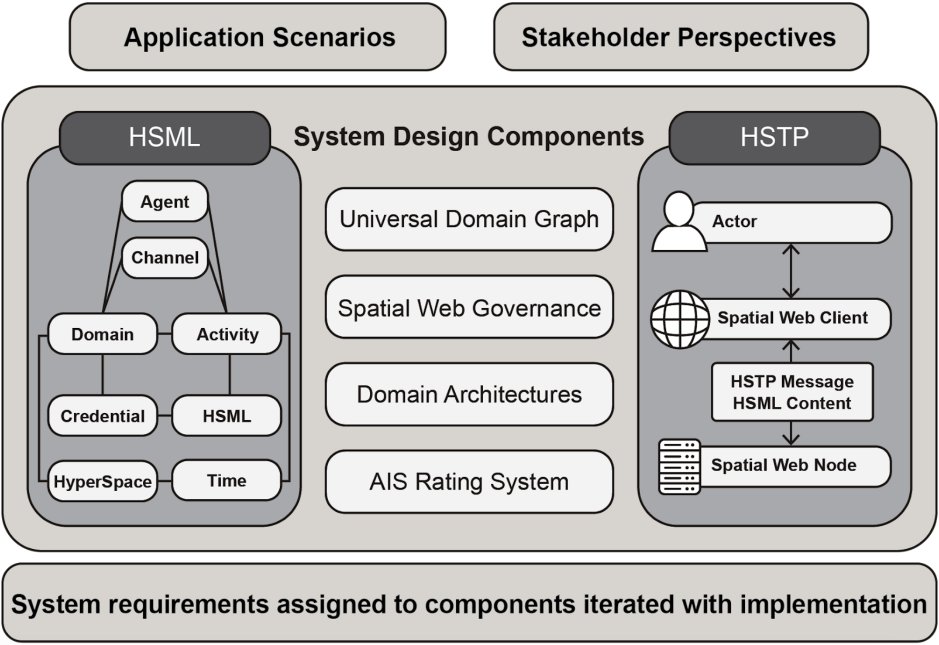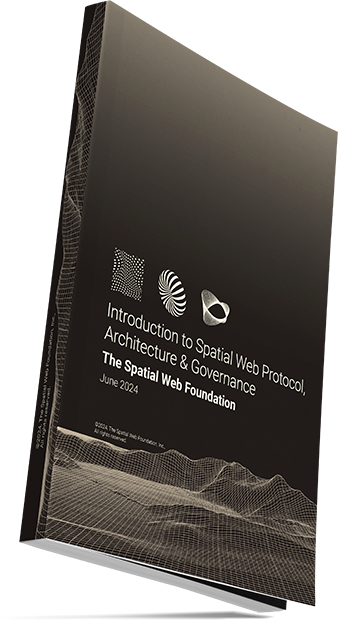IEEE P2874 Spatial Web Protocol, Architecture and Governance Standard.
SWF and IEEE SA are collaborating on a socio-technical governance and system standard for the Spatial Web. The collaboration meets rigorous requirements to become a globally adopted IEEE standard, informed by IEEE’s Ethically-Aligned Design P7000 Series, and focused on Autonomous Intelligent Systems. The formation of the IEEE P2874 Spatial Web Working Group was deemed a “public imperative.”
Several types of standards are under development: A socio-technical system standard as IEEE P2874; Implementation standards for HSML, HSTP, and UDG; Policy guidance for Spatial Web Federated Governance; and Domain-specific Architectures for various vertical applications.
The IEEE P2874 specification defines the scope, key concepts and a reference model for Spatial Web components, services and specifications. The architecture of the system is portrayed in three viewpoints: Stakeholders, Knowledge, and Distributed Computing. As a system design specification, it provides design requirements for the standards listed below. SWF developed an Introduction to the Spatial Web Protocol, Architecture and Governance.
Download the June 2024 Spatial Web Specification Introduction
Figure title: IEEE P2874 Spatial Web defines a system design composed of 6 components.

1. HSML Implementation Standard
Hyperspace Modelling Language (HSML) is a human- and machine-readable modeling language and semantic data ontology schema that describes entities and their relationships in the Spatial Web. It defines an extensible model for encoding graphs and provides JSON examples. As an implementation standard, it provides testable requirements that enable independent implementations to interoperate.
2. HSTP Implementation Standard
Hyperspace Transaction Protocol (HSTP) is a protocol designed to underwrite the automated contracting that is required to build a coherent, decentralized, secure, and privacy-respecting Spatial Web. It provides APIs for several distributed computing platforms. As an implementation standard, it provides testable requirements that enable independent implementations to interoperate.
3. Universal Domain Graph System Specification
The Universal Domain Graph (UDG) is a distributed metagraph which contains all relationships between all known entities in the Spatial Web. As a system specification, it provides requirements for the updates, search and management across the distributed Spatial Web nodes hosting portions of the overall UDG.
4. Spatial Web Federated Governance
The Spatial Web is an information infrastructure for society. The governance of the Spatial Web will need to address societal and management issues, e.g., privacy, location information, trust, and federated identity. The Governance Policies will implement the SWF Charter and Ethical Principles. As a set of policies, this will define the governance across the multiple Spatial Web domains.
5. Domain-specific Architecture Specifications
The Spatial Web is composed of heterogeneous domains. To operate effectively, some vertical communities will define an architecture for their domains, e.g., transportation, manufacturing, energy, etc. As an architecture specification, this will define the concepts relevant to the domain and tailor the Spatial Web system design to meet the requirements of the particular domain.
6. AIS Rating System
Autonomous Intelligent Systems (AIS) are agents operating in the Spatial Web. Intelligent behavior reflects the capacity of an agent to make informed decisions, plan actions, adapt, and execute tasks in coordination with or in response to other Spatial Web entities. The AIS framework is a multi-level rating system for autonomous intelligent agents that will serve as a basis for their governance in the Spatial Web. The system is designed to evaluate and rate the level and scope of an agent’s autonomous intelligent capabilities when operating in complex environments or as part of larger ecosystems of intelligence. This rating system will serve as a foundational component for managing and assessing the performance, trustworthiness, and interoperability of AIS agents operating within the Spatial Web ecosystem.
Steps to participation in the Working Group:
- Sign up for the WG’s public reflector
- Attend the next WG meeting on January 24th. Details are posted here
- Review and accept the IEEE Privacy Policy


